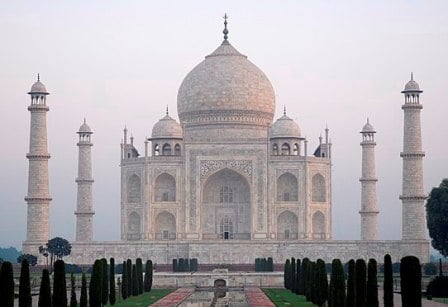The great Taj Mahal is a mausoleum, built with ivory and white marble. It is located at the right bank of the Yamuna River in the city of Agra, Uttar Pradesh State, India. The Taj Mahal is an Islamic origin.
Taj Mahal was started in the year 1632. It was constructed from 1628 to 1658, during the reign of Mughal Emperor “Shah Jahan”. He was built commissioned the Taj Mahal to build the tomb of his favorite wife Mumtaz Mahal.
After that, he was also builds the tomb of Shah Jahan himself. The Taj Mahal was spanning overall 17 hectares (42 acres).
Taj Mahal was a set of the formal gardens. It has bounded with the 3 sides of the crenellated wall. Taj Mahal is integrated with the design traditions of Indo-Islamic architecture.
Taj Mahal exemplifies early Mughal Empire architecture. The Specific inspiration had come from the successful Timurid and the Mughal buildings. In Taj Mahal buildings are included the Gur-e Amir tomb of Timur. Timur was the ancestor of the Mughal dynasty and tomb was located in Samarkand, Uzbekistan.

Taj Mahal is one of the top 7 Wonders in the World.
In the past Mughal Empire buildings were mainly built using red sandstone. But, Shah Jahan liked white marble designs and encouraged to build Taj Mahal with white marble. The white marble was inserted with the semi precious stones.
In this time, the buildings under Shah Jahan patronage had reached to the new levels of the refinement. The tomb of Mumtaz Mahal is located in the center of the entire Taj Mahal complex.
Great Taj Mahal Tourists Visitor Timings.
The grounds of Taj Mahal are open from 06:00 (6 AM) to 19:00 (7 PM) on weekdays. Taj Mahal complex is closed for prayers at the mosque on Fridays. The mosque is open from 12:00 and 14:00 (2 PM) on Fridays.
Night viewing of the Taj Mahal is available on the day of the full moon. The Taj Mahal complex is open for night viewing two days before and after the full moon day. The Taj Mahal complex is not open for night viewing on Fridays or during the month of Ramadan.
Taj Mahal is a large white marble structure standing on the square base.
Taj Mahal was consisted of a symmetrical design. It had an arch shaped doorway of iwan (rectangular space or hall). Taj Mahal basic elements are indo-Islamic origin like all Mughal tombs.
Taj Mahal base structure was a large, multi chambered cube. The cube had chamfered corners. It had formed an unequal, 8 sided structure. Each 4 long sides of the building are approximately 55 meters (180 feet).
Each side of the iwan was framed with the huge pishtaq. Pishtaq is known as the formal gateway to the iwan. The pishtaq is a vaulted archway. Pishtaq has two similar shaped arched balconies that are stacked on either side. These designs of the stacked pishtaqs are replicated to the chamfered corner area. It has made the design completely symmetrical on all the sides of the building.
The 4 minarets frame of the Taj Mahal tomb one at the each corner of the plinth. It has facing to the chamfered corners.
Taj Mahal main chambers are the false sarcophagi (coffin) of Mumtaz Mahal and Shah Jahan.
In the year 1643, the construction of the mausoleum was completed. But the work had continued on the other phases of the project for the 10 years.
The entire construction of the Taj Mahal was completed in the year of 1653.
In that time, Taj Mahal construction cost was estimated as 32 million INR. In the year 2020, it would be approximately 70 billion INR ($1 million USD).
The construction of Taj Mahal project employed around 20,000 artisans. This was headed by Ustad Ahmad Lahauri, the court architect to the Emperor.
It has been designated as the UNESCO World Heritage Site in the year 1983.
In 2007, Taj Mahal attracted more than 6 million visitors.
Taj Mahal is one of the world’s admired masterpieces of cultural heritage. It was the Muslim art in India is renowned.
Taj Mahal regarded by the Mughal architecture and the symbol of the India’s rich history.
